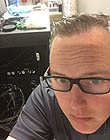|
|
This topic comprises 3 pages: 1 2 3
|
|
Author
|
Topic: where best to put filters to "stop down" the light
|
|
|
|
|
|
|
|
|
|
|
|
|
|
|
|
|
Richard P. May
Expert Film Handler
Posts: 243
From: Los Angeles, CA
Registered: Jan 2006
|
 posted 04-07-2008 10:20 AM
posted 04-07-2008 10:20 AM




In our laboratory screening room, the "natural" light from 1k lamps is too bright for the screen size. We have placed neutral density gel filters, which are in a home-made frame, directly in front of the lenses. The light intensity can be easily corrected, and we see no effect at all on the projected image.
The filters are simply taped to the front of the Norelco FP20 cases, in a position that they do not get in the way of the door.
We previously had the filters on the rear of the porthole glass. This wasn't good, as the light bounced back from the glass onto the filter, then to the front again, putting a sort of ghost image on the screen whenever there was a bright part of a scene.
Previously, I had made small filters and mounted them in a 35mm still photo slide mount. These were placed in front of the projector gate, behind the lens. On a Simplex XL it worked fine, as the gate assembly almost invites such a unit. The Norelcos aren't built that way, and it was hard to keep it in place. There was never any melting or fading of the filters, regardless of the fact they were right in front of the film.
The same technique can be used for color correction filters if the lamps are not putting out evenly colored light.
The theory of the scope lens only transmitting half of the light of a flat lens to the screen doesn't work in practice. We only find a difference of about 3 fl drop, and to compensate for this, swing the ND filters out of the light path.
Don't forget, the light is being spread double only in the horizontal direction. To make a 50% reduction I think it would need to be both twice as high and twice as wide.
RPM
| IP: Logged
|
|
|
|
|
|
|
|
|
|
|
|
|
|
|
|
All times are Central (GMT -6:00)
|
This topic comprises 3 pages: 1 2 3
|
Powered by Infopop Corporation
UBB.classicTM
6.3.1.2
The Film-Tech Forums are designed for various members related to the cinema industry to express their opinions, viewpoints and testimonials on various products, services and events based upon speculation, personal knowledge and factual information through use, therefore all views represented here allow no liability upon the publishers of this web site and the owners of said views assume no liability for any ill will resulting from these postings. The posts made here are for educational as well as entertainment purposes and as such anyone viewing this portion of the website must accept these views as statements of the author of that opinion
and agrees to release the authors from any and all liability.
|

 Home
Home
 Products
Products
 Store
Store
 Forum
Forum
 Warehouse
Warehouse
 Contact Us
Contact Us




 Printer-friendly view of this topic
Printer-friendly view of this topic















